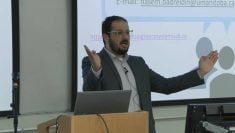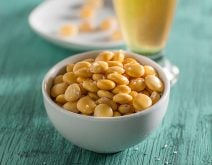When a group of farmers near Pierre, South Dakota, established the Dakota Lakes Research Farm in 1986, their main focus was on irrigation and water issues.
At the recent Regenerative Agriculture Forum in Brandon, Man., Dakota Lakes research and production manager, Dwayne Beck, described how he and his team have focused on better managing the whole ecosystem to improve not just the water cycle on the farm, but all the other dynamics that make up an efficient, functioning and resilient farming system.
The farm has been a no-till operation since the beginning, and Beck has replaced cultivation with other practices that ensure the water, energy and mineral cycle function properly.
Read Also

Claas brings 1000 Series SP forage harvesters to Canada
In mid-August, Claas unveiled its new line of Jaguar forage harvesters at an event in Visalia, California, deep in the heart of that state’s dairy region.
Much of the land at Dakota Lakes had traditionally been irrigated. The water cycle, says Beck, was broken until he introduced regenerative practices.
Ensuring that there are plant roots growing in the soil for as long as possible allows water to go through the plants. This serves to dry wet soils through transpiration, allowing the land to harvest sunlight and cycle minerals.
“Now we can put on two inches of water in nine minutes and walk behind the irrigators without getting our feet muddy,” says Beck. “There is no run-off or waterlogged soil. There is armour on the soil surface and visible macropores for water and oxygen to go into, so the soil can breathe.”
Beck says 80 per cent of ag input costs can be traced directly to energy. “When a system uses sunlight, it is a benign, constant and free energy source, whereas fossil fuels are potentially damaging to ecosystems, are external and certainly not free,” he says.
In conventional farming systems, a lot of minerals and nutrients are exported from the land rather than recycled locally. For example, a 120 car load of soybeans contains 200,000 kilograms of phosphate. On the other side, excess artificial fertilizer use can lead to salinity and water degradation. “What’s in a saline sink is fertilizer,” says Beck. “It has moved beyond the root zone, the water holding capacity has been exceeded, and it reaches an impermeable layer then goes sideways and comes out someplace else.”
Catch and release
Beck calls his nutrient cycling system “catch and release.” With extended crop rotations and increased plant diversity, organic matter in the soil increases. Nutrients tied up in that organic matter take a while to release, which means a different fertilizer strategy is needed.
“We put some starter P [phosphorus] with the seed and other nutrients are placed near the row [side banded] when we are seeding, or on the soil surface after the crop canopy develops,” says Beck. “If you broadcast fertilizer before or at seeding you are feeding the weeds.”
Beck says there are three key factors for nutrient cycling: available nutrients, moisture and plant roots. “If you have mycorrhizal fungi in a long-term no-till system, you can run with much lower soil P test levels than you can in conventional-till systems,” says Beck.
Proper plant intensity and diversity in rotations gives stable and sustainable profitability, says Beck. “Most of the plant growth problems that are blamed on no-till are the result of inadequate diversity and improper intensity.”
To determine the proper intensity of plants needed in a farming system, take a lesson from native vegetation, says Beck. “Native vegetation is the best indicator of the range of intensities that are appropriate for the location,” he says. Ideally, there should be plants growing all the time or as much as possible, especially in moist areas with short growing seasons. Cover crops or relay cropping can increase field cover.
Organic matter
To effectively build organic matter in the soil, it is important to have a mix of low-residue and high-residue crops throughout the rotation.
Higher plant residue results in higher carbon in the soil, which builds soil organic matter over time. But this is not a fast process, and it depends on climate and soil factors.
Organic matter improves soil structure, feeds soil biology and increases the soil’s water holding capacity. When organic matter increases from one to three per cent, available water capacity doubles. When organic matter reaches four per cent, it accounts for 60 per cent of the soil’s annual water holding capacity.
Diversity
Beck recommends planting at least three crop types with long intervals of two to four years between them to break disease and weed cycles. “The worst rotation is every other year with things like wheat/canola or corn/soybeans,” says Beck.
He’s done the research to back up his statements. A 12-year study on a one-half section of land at Dakota Lakes looked at different crop rotations and their long-term effects on things like yield and weed pressure.
The farm found that diverse crop rotations have a positive effect on yields. Adding cover crops to a corn/soybean rotation increased soybean yield by an average of 7.3 bushels per acre. A rotation of soybean and winter wheat plus a cover crop gave a 62.9 bu./ac. soybean yield compared with an expected soybean yield of 55 bu./ac. without the cover crop component.
In a longer rotation of corn/corn/soybean/wheat/soybean, the yield of the first soybean crop in the rotation without a cover crop was 71.3 bu/ac and the yield for the second year of soybeans following a cover crop addition gave 81.2 bu./ac.
“A cover crop increased soybean yield by 7.3 bu./ac., but more importantly, crop diversity increased soybean yield by 15.9 bu./ac.,” says Beck.
The thing to bear in mind about crop rotation, adds Beck, is that it takes time to see the benefits. “Short-term studies are not accurate in evaluating treatments such as tillage or rotations, which have long-term impacts,” he says.
What about economics?
Beck admits that farmers who use a shorter rotation or two higher value crops, such as corn and soybeans, often question whether the Dakota Lakes farm can make money, given that they add lower value crops like peas into their longer rotation.
Taking field-scale data from its rotation trials: corn yield in continuous corn averaged 203 bu./ac., and 217 bu./ac in a corn/soybean rotation. In a longer rotation, corn/corn/soybean/wheat/soybean, the corn yield average was 235 bu./ac. (first and second year combined). Soybeans averaged 63 bu./ac. in corn/soybeans and 76 bu./ac. in the more diverse rotation. The wheat yield averaged 120 bu/acre.
Scaling that up to 5,000 acres, average yields for all crops in the same rotations were 1,015,000 bu (continuous corn), 442,000 bu corn, 157,250 bu. soybean (corn/soybean) and 470,000 bu. corn, 157,000 bu. soybean and 120,000 bu. wheat (corn/corn/soybean/wheat/soybean).
“Does it make sense to trade 72,000 bushels of corn for 120,000 bushels of wheat and 350 bushels of soybean with fewer pest issues and less input cost?” says Beck.
The farm added a long-term rotation with perennial cover crops this year, using an intercrop of corn and alfalfa. One row of alfalfa is seeded, then two rows of corn beside it and another row of corn again on 20-inch row spacings. After four years, they will move the alfalfa rows 20-inches over and begin again. After harvesting the corn, cows graze the stalks.
“We have continuous corn and also continuous alfalfa in there,” says Beck. “We don’t graze the alfalfa, it’s there to do the cycling; alfalfa roots will go deep to bring the nutrients up, and it should be feeding nitrogen to the corn.”
Beck says it takes some time for the system to get working properly.
Managing weeds and disease
Weeds and disease are nature’s way of adding diversity to a system, explains Beck. Nature can be countered by adding natural, beneficial biological diversity such as cover crops.
“If you have a weed, insect or disease, ask yourself, ‘Where did I give it the opportunity?’” says Beck.
Address the weakest point in the life cycle of that organism. For example, “The best way to address weeds is to not let them produce seeds in the first place.”
Dakota Lakes has not used any broadcast insecticides in 17 years because they have had no need for them. The farm uses herbicide sparingly and fungicides rarely, using longer, diverse crop rotations to disrupt weed and disease cycles. “Crop rotation allows time for natural enemies to destroy the pathogens of one crop while unrelated crops are grown, but it takes biological time that we need to allow for it to work.”
Is tillage catastrophic?
Dakota Lakes has been no-till since the outset. Beck believes that tillage is to agriculture what fracking is to petroleum, in that both increase the speed and extent of the removal of compounds from the ecosystem.
The Dakota Lakes system replaces tillage with other cultural practices such as good sanitation, crop rotation and plant competition.
“No-till is about managing your soil water, soil structure, soil biology and soil carbon,” says Beck. “In nature, tillage is a catastrophic event.”
The no-till system is key in managing weeds. In a seed survival trial comparing tillage and no-tillage systems, weed seeds left at the surface of the soil (no-till) after two years had 11 per cent live seeds present, whereas seeds buried at two inches and four inches had 28 per cent and 55 per cent live weed seeds present, respectively.
Livestock integration
Regenerative agriculture practitioners generally agree that integrating livestock into the system is essential to make it function effectively and efficiently and provide maximum profit.
Beck began to introduce livestock into the Dakota Lakes system about five years ago. Now the cow-calf herd stays on the land year-round. “In dry, brittle climates, soil biology slows down during times of low soil moisture or low soil temperatures,” he says. “But the rumen of grazing animals remain moist and warm, continuing the biological processes.”
There have been many changes and lessons learned at Dakota Lakes over the past 33 years. The major lesson, according to Beck, is doing the right thing environmentally is almost always the correct economic approach in the long run.















